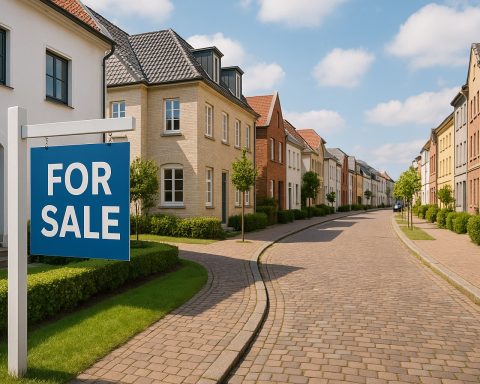Boise’s real estate market in 2025 remains fiercely competitive. Median home prices are near record highs (~$500K in Apr 2025), up about 2% year-over-year redfin.com. Homes sell extremely fast – a typical listing goes pending in ~12 days (median) redfin.com. Supply is razor-thin: only ~642 homes were listed (for-sale inventory) at the end of April 2025 zillow.com. As a result, most sales meet or exceed list price (about 25% sell above list) zillow.com. Meanwhile, rents are surging: the average rent in Boise (Q4 2024) was about $1,935/month, a +11.8% increase over the prior year weknowboise.com. Vacancy remains extremely low (~1.6% for all rentals weknowboise.com), indicating intense demand.
Key 2025 Market Data:
| Metric | Boise (2025) | Source |
|---|---|---|
| Median Sale Price (Apr 2025) | ~$500,000 (+2.2% YoY) | redfin.com |
| Homes Sold (Apr 2025) | 220 (–12.0% YoY) | redfin.com |
| Median Days on Market | 12 days (+1 day vs 2024) | redfin.com |
| For-Sale Inventory (Apr 30) | 642 homes | zillow.com |
| New Listings (30 days to Apr) | 308 listings | zillow.com |
| Median List Price (Apr 30) | $549,283 | zillow.com |
| Median Sale Price (Mar 31) | $487,333 | zillow.com |
| Sale/List Price Ratio (Mar) | 0.995 | zillow.com |
| Average Rent (All Units) | $1,935/month (+11.8% YoY) | weknowboise.com |
| Rental Vacancy Rate | 1.62% | weknowboise.com |
Key Market Drivers (2025)
- Population Growth & Migration: Boise’s population keeps climbing. Ada County (Boise metro) reached ~~557,600 people (2024) compassidaho.org (up ~62,600 since 2020). Boise city itself is ~250,000 in 2024 compassidaho.org, reflecting in-migration from high-cost regions. Idaho is a top inbound state – a 2024 moving-services report found 69% of moves into Idaho were inbound, making Idaho #1 nationally cdapress.com. Many newcomers cite affordability and quality of life. Boise benefits from remote/hybrid work trends: “Cities like Boise are benefiting from… hybrid work, combining strong job markets with a high quality of life” cdapress.com.
- Jobs & Economy: Boise’s economy is robust. Unemployment in the Boise MSA is very low (~3.2% in April 2025) bls.gov, and total nonfarm jobs are roughly 410,000 (Apr 2025) bls.gov. Key sectors are expanding: e.g. construction jobs are up ~10.5% YoY bls.gov, manufacturing +4.6%, financial (+5.8%), and tech/healthcare maintain steady hiring bls.gov bls.gov. Major employers (chipmaker Micron, high-tech, healthcare systems like St. Luke’s, and food processors) anchor growth. Between 2018–2023 Boise added ~17.3% more jobs (among the fastest in the U.S.) brevitas.com. Economic reports rank Boise near the top of growth indices – one analysis even named Boise the #1 U.S. market for investors in 2025 brevitas.com. These factors (jobs, wages, low taxes) keep local demand strong.
- Housing Demand: The combination of in-migration and employment fuels steady buyer/renter demand. Low mortgage rates (recently ~6–7%) still leave many scrambling for homes. Despite high prices, buyer activity has so far only modestly slowed – Redfin reports April 2025 sales down ~12% YOY, largely due to lack of inventory redfin.com. Notably, existing homeowners (especially retirees and tech workers) continue moving in, keeping market pressure high.
- Neighborhood & Amenities: Boise’s reputation for outdoor recreation, parks, and good schools amplifies demand. New transit options and trails are also making city living more attractive. For example, zoning along transit corridors (like Fairview Ave) was recently changed to allow denser projects boisedev.com, reflecting city efforts to match infrastructure with housing needs.
Government Policies & Regulations
- Zoning Overhaul: In 2023 Boise adopted a completely new zoning code to encourage diverse housing (mixed-use, infill, ADUs, multiplexes). In its first year, city planning data showed over 400 homes approved in mixed-use zones and 190 in urban-residential areas boisedev.com. Large multi-family projects dominated, while only 1% of new units were duplexes boisedev.com – the city is now tweaking rules to encourage more townhouses/duplexes. A major outcome was a 113% jump in new ADU (Accessory Dwelling Unit) permits – 130 ADUs approved in 2024 versus ~61 on average previously boisedev.com. In short, Boise’s code is actively being refined (e.g. simpler CUP approvals, incentives) to increase supply and affordability.
- Affordable Housing Initiatives: Boise has long used an inclusionary approach via an affordable housing trust. Under this program the city buys/leasing land and partners with developers to cap rents. In June 2025 the City Council unanimously approved a 212-unit, 6-story affordable rental project on the West Bench (at 1505 N. McKinney) boisedev.com. All units will target households ≤60% of AMI (about $1,029/mo for a one-bedroom) boisedev.com. This “McKinney” project leveraged the zoning code rewrite (the site was rezoned to MX-3 for transit proximity) boisedev.com. Neighboring residents had raised concerns (taller building, parking), illustrating the tension between density and community expectations.
- State Policies: Idaho generally has a pro-development stance. The state bars rent control or mandatory affordable housing quotas, and in 2023 it began requiring licensing of vacation/rental properties (reducing unregulated short-term rentals). Crucially, Idaho’s business-friendly taxes and limited land-use regulation continue to attract developers and keep building costs lower than in some states. Boise levies impact fees and has streamlined permitting to try to meet housing demand, but on the whole policy remains favorable for expansion.
New Construction & Major Developments
Boise’s construction pipeline is very active, especially for multifamily housing. For example, 3,064 apartment units were under construction in the Boise‐Nampa area as of Q3 2024 crexi.com (nearly triple the ~1,000 units delivered in 2024). The combination of high demand and new zoning incentives has spurred many large projects:
Other notable trends: In residential neighborhoods across Boise, permit counts are rebounding from 2022 lows but still below the 2019 peak. Builders report higher costs (e.g. lumber tariffs, insurance) that dampen some activity. Nevertheless, over 861 apartment units were delivered in 2024 and hundreds more single-family lots opened crexi.com. Because ~40% of Idaho’s active listings are new construction (the highest share nationally) brevitas.com, entry-level buyers now see more options, which has stabilized home prices even as demand remains strong.
Rental Market (2025)
- Rental Rates: Boise’s rents are among the fastest-growing in Idaho. As of late 2024, the average rent (all property types) was ~$1,935/month weknowboise.com – an 11.8% jump from a year earlier weknowboise.com. By bedroom: 3BR houses average ~$2,555, while 1BR apartments average ~$1,300 weknowboise.com weknowboise.com.
- Vacancy: Rental vacancies remain extremely low (~1.6% across all units weknowboise.com, down from 1.8% a year prior). Institutional surveys (CBRE, Costar) echo this: Boise multifamily had 94.6% occupancy by Q3 2024 crexi.com.
- New Supply: The big pipeline of multifamily (3,064 units under construction) means more apartments hitting the market soon, which should moderate rent growth by late 2025–2026. Still, near-term the market favors landlords: rents keep edging up (Zillow’s index was +2.2% YoY in April 2025 zillow.com), and demand exceeds supply in most submarkets.
Commercial Real Estate (2025)
Boise’s commercial sectors are healthy but varied:
- Industrial/Logistics: Demand is booming. Boise MSA has ~56.4 million sq.ft of industrial space, with vacancy ~8.3% (Q3 2024) crexi.com. CBRE reported just ~7.4% vac in Q1 2025 brevitas.com as new facilities lease up. Over 1.3 million sq.ft. of new industrial space was under construction in early 2025 brevitas.com (much to serve Micron’s upcoming fab and Amazon’s distribution needs). Average asking rents are around $13–15/sqft (NNN) for warehouse space crexi.com. Many large sites (e.g. 520-acre park south of the airport) are planned for warehousing and manufacturing, attracting REITs and institutional capital.
- Retail: Boise’s retail market remains solid. Total inventory is ~25.35M sq.ft with very low vacancy (~3.3% in Q3 2024) crexi.com. Suburban nodes like Nampa and Meridian lead demand (Nampa’s retail vac was ~6.9% in 2024 crexi.com). Asking rents average ~$20–22/sq.ft (NNN) tokcommercial.com (Class A centers averaging ~$28). Recent large leases (e.g. 16,000 sq.ft Grocery Outlet) and new shopping centers reflect continued consumer activity. However, retail development is cautious – the supply of new retail space is growing slowly.
- Office: The office sector is in a mild slowdown. Boise’s office inventory is ~17.3M sq.ft with roughly 10–11% vacancy crexi.com brevitas.com (well below the U.S. average ~19%). Demand holds up thanks to local firms (finance, tech, healthcare) leasing space. The average asking rate is ~$19/sq.ft (per Crexi data, Nov 2024) crexi.com. Several submarkets (downtown, West Boise, Meridian) see higher demand, while others (e.g. Central Bench) have some empty blocks. New office construction is minimal, so the vacancy rate is stabilizing rather than spiking.
Investment Insights
- Residential Investments: Boise’s housing has delivered strong appreciation over the past decade. For example, by 2024 the median home was ~double its 2014 price brevitas.com. Luxury homes saw especially massive gains (top-quartile values +150% since 2017 brevitas.com). Short-term outlook: high mortgage rates and new supply have cooled the market; Redfin data showed early-2024 median sales about $450K (–6.3% YOY) brevitas.com. However, long-term growth fundamentals remain intact. Investors note Boise’s blend of strong long-term growth with a more balanced short-term outlook brevitas.com. Rental housing still yields well: with rents near $1,600 for a 3BR crexi.com and very high occupancy (94.6%), landlords can expect ~4–6% gross yields on new properties. On the other hand, record-high purchase prices mean net cap rates for quality housing are relatively low (~4–5%). Overall, many analysts rate Boise highly for investors – one 2025 forecast actually ranked Boise #1 nationwide for real estate investment, noting its ~$500K median price and sub-30-day sales pace brevitas.com.
- Commercial Investments: Industrial/logistics is the top target. Low vacancies (~7–8% crexi.com brevitas.com) and the region’s strategic location (I-84 corridor) have driven institutional interest. In fact, REITs and private equity have begun funding Boise industrial parks and warehouses brevitas.com. Typical cap rates in this sector are in the mid-5% range. Retail properties offer modest returns (cap rates ~6–7%) and are generally leased to credit tenants. Low vacancy (~3–4%) keeps rent growth positive, but expensive land and sparse new projects limit supply. Office investments are more cautious due to ~10% vacancy and uncertain demand. Most large investors focus on multi-tenant downtown or suburban office buildings with long-term leases; small “trophy” office trades can still find ~5-6% cap rates given Boise’s low-interest-rate environment.
2026–2028 Forecast
Looking ahead, most experts expect steady but slower growth in Boise’s market. After the pandemic boom, double-digit jumps are unlikely, but fundamentals remain healthy. Nationwide and Idaho-focused forecasts generally predict ~4–6% home price appreciation in 2025 wave-property.com, with Boise roughly on pace. By 2026–2028, continued demand (from net migration and job gains) is likely to outstrip supply just slightly, keeping Boise a mild seller’s market. We project modest annual price gains (3–5%) for the next few years. Key factors:
- Interest Rates: If mortgage rates stay around 6–7%, buyer demand will be somewhat constrained but not evaporate. Higher borrowing costs mean some buyers will wait or look for cheaper options (e.g. smaller homes, farther suburbs).
- Supply: The large pipeline (especially of apartments) will soften the housing shortage. Idaho’s recent building boom – 40% of active listings are new homes brevitas.com – suggests entry-level prices will stop rising rapidly. As new subdivisions and rentals come online in 2026–2028, inventory should recover modestly.
- Economy and Jobs: The Micron chip fab (under construction now) and other expansions will add thousands of jobs by 2026–27, boosting housing demand. Continued state in-migration (especially from California/AZ) is expected. Boise’s unemployment is unlikely to rise much above current lows, supporting steady homebuying and renting.
In summary, experts believe Boise will not crash but likely cool. Price growth will moderate as affordability tightens, but not reverse. A balanced market (close to 6 months supply) may emerge later this decade, rather than the extreme seller’s conditions of 2020–2022. For investors and homebuyers alike, Boise through 2028 will likely offer consistent, if unspectacular, gains – a “soft landing” scenario in the regional housing market.
Sources: Official MLS data, local REALTOR® reports, and industry analyses (Boise Regional REALTORS®, Tok Commercial, BoiseDev, CREXi, BLS, Census/Compass, etc.) were used throughout to provide current stats and expert insights redfin.com weknowboise.com crexi.com brevitas.com. All trends and projections are based on these reputable sources and are subject to change with economic conditions.












